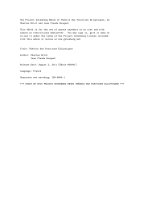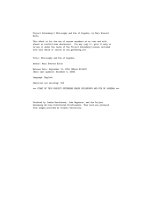Outlines of Greek and Roman Medicine, by James Sands Elliott This eBook is for the use of anyone anywhere at no cost and with almost no restrictions whatsoever. You may copy it, give it away or re-use it under the terms of docx
Bạn đang xem bản rút gọn của tài liệu. Xem và tải ngay bản đầy đủ của tài liệu tại đây (1.56 MB, 425 trang )
The Project Gutenberg EBook of Outlines
of Greek and Roman Medicine, by
James Sands Elliott
This eBook is for the use of anyone
anywhere at no cost and with
almost no restrictions whatsoever. You
may copy it, give it away or
re-use it under the terms of the Project
Gutenberg License included
with this eBook or online at
www.gutenberg.org
Title: Outlines of Greek and Roman
Medicine
Author: James Sands Elliott
Release Date: May 5, 2007 [EBook #21325]
Language: English
*** START OF THIS PROJECT GUTENBERG
EBOOK GREEK AND ROMAN MEDICINE ***
Produced by Suzanne Lybarger, LN
Yaddanapudi, Brian Janes
and the Online Distributed Proofreading
Team at
OUTLINES OF
GREEK AND
ROMAN
MEDICINE
ASKLEPIOS
The ancient Greek Deity of Healing.
From Wellcome's Medical Diary (Copyright)
By permission of Burroughs Wellcome & Co.
OUTLINES OF
GREEK AND
ROMAN
MEDICINE
BY
JAMES SANDS
ELLIOTT, M.D.,
Ch.B.(Edin.)
Editor of the "New Zealand Medical Journal,"
Honorary Surgeon to the Wellington Hospital, New
Zealand.
Illustrated
milford house inc.
boston
This Milford House edition is an
unabridged republication of the edition
of 1914.
Published in 1971 by MILFORD
HOUSE INC. Boston, Massachusetts
Library of Congress Catalogue Card
Number 76-165987
Standard Book Number 0-87821-036-9
Printed in the U.S.A.
TO MY FATHER
PREFACE.
I was stimulated to write these Outlines
of Greek and Roman Medicine by a
recent sojourn in the south-eastern part
of Europe. The name of the book
defines, to some extent, its limitations,
for my desire has been to give merely a
general outline of the most important
stages in the advancement of the healing
art in the two Empires to which modern
civilization is most deeply indebted.
There are a few great works on the
history of medicine by continental
writers, such, for instance, as those by
the German writers, Baas, Sprengel, and
Puschmann, but, generally speaking, the
subject has been much neglected.
I cherish the hope that this little work
may appeal to doctors, to medical
students, and to those of the public who
are interested in a narration of the
progress of knowledge, and who realize
that the investigation of the body in
health and disease has been one of the
most important features of human
endeavour.
The medical profession deserves
censure for neglect of its own history,
and pity 'tis that so many practitioners
know nothing of the story of their art.
For this reason many reputed
discoveries are only re-discoveries; as
Bacon wrote: "Medicine is a science
which hath been, as we have said, more
professed than laboured, and yet more
laboured than advanced; the labour
having been, in my judgment, rather in
circle than in progression. For I find
much iteration, and small progression."
Of late years, however, the History of
Medicine has been coming into its
kingdom. Universities are establishing
courses of lectures on the subject, and
the Royal Society of Medicine recently
instituted a historical section.
The material I have used in this book has
been gathered from many sources, and,
as far as possible, references have been
given, but I have sought for, and taken,
information wherever it could best be
found. As Montaigne wrote: "I have here
only made a nosegay of culled flowers,
and have brought nothing of my own but
the thread that ties them together."
I have to express my indebtedness to my
friend, Mr. J. Scott Riddell, M.V
.O.,
M.A., M.B., C.M., Senior Surgeon,
Aberdeen Royal Infirmary, for his great
kindness in reading the proof-sheets,
preparing the index and seeing this book
through the press and so removing one of
the difficulties which an author writing
overseas has to encounter; also to my
publishers for their courtesy and
attention.
James Sands Elliott.
Wellington,
New Zealand.
January 5, 1914.
CONTENTS.
PREFACE.
CONTENTS.
ILLUSTRATIONS.
CHAPTER I.
Early Roman Medicine.
Origin of Healing
Temples
Lectisternium
Temple of Ỉsculapius
Archagathus
Domestic Medicine
Greek Doctors
Cloaca Maxima
Aqueducts
State of the early Empire
CHAPTER II.
Early Greek Medicine.
Apollo
Ỉsculapius
Temples
Serpents
Gods of Health
Melampus
Homer
Machaon
Podalarius
Temples of Ỉsculapius
Methods of Treatment
Gymnasia
Classification of Renouard
Pythagoras
Democedes
Greek Philosophers
CHAPTER III.
Hippocrates.
His life and works
His influence on Medicine
CHAPTER IV.
Plato, Aristotle, the School of
Alexandria, and Empiricism.
Plato
Aristotle
Alexandrian School
Its Origin
Its Influence
Lithotomy
Herophilus
Erasistratus
Cleombrotus
Chrysippos
Anatomy
Empiricism
Serapion of Alexandria
CHAPTER V.
Roman Medicine at the end of the
Republic and the Beginning of the
Empire.
Asclepiades of Prusa
Themison of Laodicea
Methodism
Wounds of Julius Cæsar
Systems of Philosophy
State of the country
Roman quacks
Slaves and Freedmen
Lucius Horatillavus
CHAPTER VI.
In the Reign of the Cæsars to the
Death of Nero.
Augustus
His illnesses
Antonius Musa
Mæcenas
Tiberius
Caligula
Claudius
Nero
Seneca
Astrology
Archiater
Women poisoners
Oculists in Rome
CHAPTER VII.
Physicians from the Time of
Augustus to the Death of Nero.
Celsus
His life and works
His influence on Medicine
Meges of Sidon
Apollonius of Tyana
Alleged miracles
Vettius Valleus
Scribonius Longus
Andromachus
Thessalus of Tralles
Pliny
CHAPTER VIII.
The First and Second Centuries
of the Christian Era.
Athenæus
Pneumatism
Eclectics
Agathinus
Aretæus
Archigenes
Dioscorides
Cassius Felix
Pestilence in Rome
Ancient surgical instruments
Herodotus
Heliodorus
Cælius Aurelianus
Soranus
Rufus of Ephesus
Marinus
Quintus
CHAPTER IX.
Galen.
His life and works
His influence on Medicine
CHAPTER X.
The Later Roman and Byzantine
Period.
Beginning of Decline
Neoplatonism
Antyllus
Oribasius
Magnus
Jacobus Psychristus
Adamantius
Meletius
Nemesius
Ỉtius
Alexander of Tralles
The Plague
Moschion
Paulus Ỉgineta
Decline of Healing Art
CHAPTER XI.
Influence of Christianity on
Altruism and the Healing Art.
Essenes
Cabalists and Gnostics
Object of Christ's Mission
Stoics
Constantine and Justinian
Gladiatorial Games
Orphanages
Support of the Poor
Hospitals
Their Foundation
Christianity and Hospitals
Fabiola
Christian Philanthropy
Demon Theories of Disease
receive the Church's
Sanction
Monastic Medicine
Miracles of Healing
St. Paul
St. Luke
Proclus
Practice of Anatomy
denounced
Christianity the prime factor
in promoting Altruism
CHAPTER XII.
Gymnasia and Baths.
Gymnastics
Vitruvius
Opinions of Ancient
Physicians on Gymnastics
The Athletes
The Baths
Description of Baths at
Pompeii
Thermæ
Baths of Caracalla
CHAPTER XIII.
Sanitation.
Water-supply
Its extent
The Aqueducts
Distribution in city
Drainage
Disposal of the Dead
Cremation and Burial
Catacombs
Public Health Regulations
APPENDIX.
Fees in Ancient Times
INDEX.









